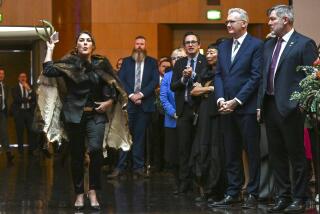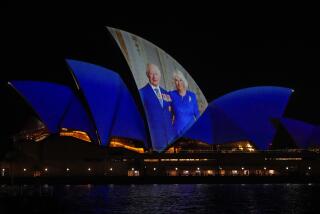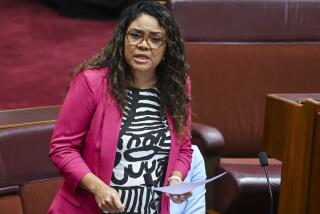AUSTRALIA: Bicentennial Celebrated : Penal Colony to Modern Nation : Australians Throw a Bicentennial Blowout
- Share via
SYDNEY, Australia — The Sydney Symphony Orchestra struck up “Waltzing Matilda” and people in pubs all over town spilled into the streets Tuesday as the descendants of convicts stood side by side with British royalty to mark the 200th anniversary of Australia’s ascent from one of the world’s most miserable penal colonies to a modern nation.
Police officials estimated that as many as 2 million Australians flocked to Sydney’s harbor for the daylong celebration, swilling millions of cans of beer, launching thousands of skyrockets and jamming the area with tall ships, small boats, helicopters and blimps.
Commentators called it “the party of the century” for a nation that learned how the hard way.
‘Worst Possible Beginning’
“From the worst possible beginnings, a great nation has been built,” Gov. Barrie Unsworth of the state of New South Wales declared in a ceremony marking the arrival of the first prisoners from Britain.
And Tuesday’s blowout was only the beginning; the party ushered in a year of celebration that is to include more than 30,000 events.
Britain’s Prince Charles said: “As history goes, 200 years is barely a heartbeat. Yet look around you and see what has happened in that time: a whole new free people.”
But even as Prince Charles spoke, more than 15,000 aborigines and thousands of white supporters were converging for a protest rally in a downtown park. They came in convoys of vans and pickup trucks from all across the country, and their banners bore such messages as “200 Years of White Lies,” “Bicentennial Invasion” and “40,000 Years Is Not a Bicentennial.”
In speeches and interviews, leaders of the aborigines, a people who have inhabited Australia for at least 40,000 years yet have never had a single treaty with the British colonists, repeated demands that they be included in government decisions and be granted absolute land rights.
Officials said that Tuesday’s peaceful rally was the largest gathering ever of aborigines, who now number about 300,000.
The Rev. Charles Harris, the aboriginal organizer of the protest, said it was an important landmark in his people’s struggle for rights.
“I’m hoping,” he said, “this will be the first step in the reconciliation process between blacks and whites in this nation.”
Prince Charles commented on the issue, briefly departing from his exultant tone to declare: “For the original people of this land it must all have seemed very different, and if they should say that their predicament has not yet ended, it would be hard to know how to answer, beyond suggesting that a country free enough to examine its own conscience is a land worth living in.”
Prime Minister Bob Hawke made no specific reference to the aborigines, although he said it was a day for all Australians to celebrate.
And they did.
For the overwhelming majority of the people, Australia Day was the ultimate party in a nation that parties perhaps more vigorously than any other on earth.
Even Patrick White, the Australian Nobel Prize-winning author who had stunned the nation last weekend by condemning the bicentennial as a circus and labeling guests Prince Charles and Princess Diana “the Royal Goons,” decided to attend.
“What a Party!” the Sun, an evening tabloid, headlined its main story on the event, going on to say that “never has there been a day on which it felt so good to be Australian.”
Temperatures in 80s
With temperatures reaching into the 80s, tens of thousands of celebrators poured out of pubs into the streets, some dancing, others flattening beer cans on their heads. A few even stopped to have an artist paint the Australian flag on their faces.
Before noon, radio and television stations were warning spectators and boat owners against joining the crowd in the harbor--not because of the rowdy behavior but because millions of people and thousands of boats had already packed the area and public transportation was snarled.
The sky above was crowded with helicopters, blimps, skywriters, even a Boeing 747, which a group said it had chartered to prove that they were “higher than a kite.” A radio commentator likened the scene to a swarm of March flies over an outback swamp.
But the harbor was not the only attraction. Thousands of Australians stood in line for hours at the cricket museum, where for the first time outside England a tiny urn containing the ashes of wickets used in a famous match 106 years ago were on display.
Air Filled With Music
Virtually everywhere in the city, trash cans overflowed, parks filled with lovers--some wearing little more than Australian flags--and the air filled with Irish music, folk songs from the outback and rock ‘n’ roll.
With typically Australian candor and self-effacing pride, many commentators noted ironic similarities between the party and the weeks of madness when the First Fleet arrived in Sydney Harbor on Jan. 26, 1788, carrying more than 700 convicts. On Feb. 6, a ship brought in 200 women convicts. Wild parties reportedly went on for some time.
“Sex orgies marked the first few weeks of the colony,” according to one of the “historical features” in the newspapers. It went on to quote from the diary of the penal colony’s doctor, who observed: “The men convicts got to them (the women) soon after they landed. It is beyond my abilities to give a just description of the scenes of debauchery and riot that then ensued.”
In all, 170,000 convicts were sent here between 1788 and 1860, when the British stopped exporting their criminal problem. The practice had begun after the American Revolution barred the British from using America as a penal colony.
Unabashed About Roots
Descendants of those first convicts, along with those of tens of thousands of British pioneers and gold miners who followed, make up the core of Australia’s overwhelmingly white population of 16 million.
True to their national personality and style, even top politicians are unabashed about their inauspicious roots. All the speakers at the ceremony commemorating the prisoners’ arrival emphasized that this was once “the worst place in the world,” but added with pride that it is now “a nation to be envied.”
Revelers were overheard defending great-great-grandfathers who picked pockets, slashed throats, robbed banks, or blasphemed against a king 200 years ago and 15,000 miles away.
Among the other events scheduled for the year is the 1988 World’s Fair starting April 30 in Brisbane; a national tour by the Chicago Symphony Orchestra; scores of boomerang-throwing contests; cockroach races; country dances; air shows, carnivals and sports competitions.
There are of course many souvenirs. Among the best-selling items are painted emu eggs, gold pins in the shape of kangaroos, koalas, wombats, wallabies and platypuses and a “bush barometer”--a length of string dangling from a cardboard square bearing the words: “If the string is wet, it’s raining.”
More to Read
Sign up for Essential California
The most important California stories and recommendations in your inbox every morning.
You may occasionally receive promotional content from the Los Angeles Times.













